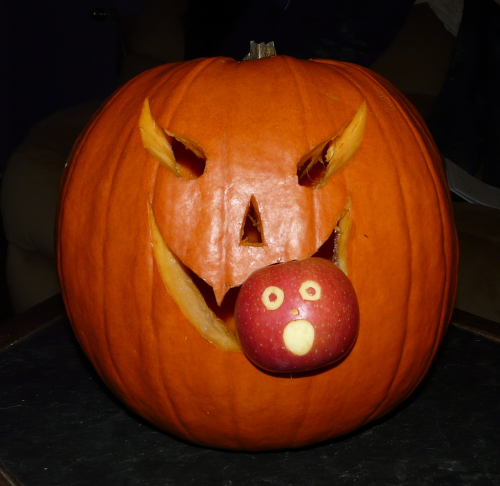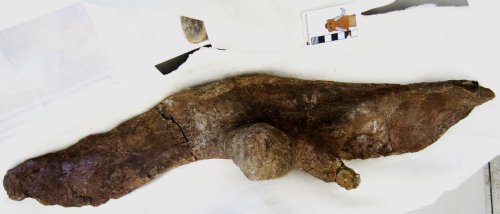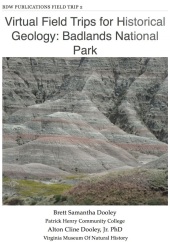 I’m endlessly fascinated by the strange skeleton of the western camel, Camelops hesternus. Camelops was a massive animal, and many of its bones were so large they can easily be mistaken for those from a bison. Yet other parts of the skeleton are almost delicate. Continue reading
I’m endlessly fascinated by the strange skeleton of the western camel, Camelops hesternus. Camelops was a massive animal, and many of its bones were so large they can easily be mistaken for those from a bison. Yet other parts of the skeleton are almost delicate. Continue reading
Category Archives: Fossil Friday
Fossil Friday – Camelops vertebra
Posted in Camels, Fossil Friday
Fossil Friday – Camelops jaw

This may look a bit like a zombie hand reaching from the grave in some B-horror movie (at least it does to me). In fact, it’s a fossil that’s quite a bit more interesting and less dangerous than a zombie hand.
Posted in Camels, Fossil Friday
Mastodons and pumpkins

Pumpkins are an interesting fruit. Curcurbita pepo is one of several domesticated species of the genus Curcurbita, vines that are native to the Americas. Curcurbita is a ecologically diverse genus, with some species needing a continuous water supply while others can live in arid conditions, so it is found natively in a variety of habitats. The fruits, which are technically berries, generally have a thick rind with a softer interior where the seeds are located. In most species the rinds are bitter, but the interior is often more palatable and rich in nutrients. As a result it became one of the first domesticated plants in North America more than 8,000 years ago. Continue reading
Fossil Friday – ammonites

Among the most abundant and aesthetically varied fossils are the ammonites. Continue reading
Posted in Fossil Friday, Invertebrate fossils
Fossil Friday – Foerestephyllum
 Corals are such an iconic part of the modern ocean, it’s easy to overlook the fact that they didn’t become widespread until the Ordovician Period, 4 billion years after the Earth formed and some 30 million years after the Cambrian Explosion. Continue reading
Corals are such an iconic part of the modern ocean, it’s easy to overlook the fact that they didn’t become widespread until the Ordovician Period, 4 billion years after the Earth formed and some 30 million years after the Cambrian Explosion. Continue reading
Fossil Friday – bourbon and geology

In a few weeks we’ll be opening our new exhibit at WSC, “Life in the Ancient Seas”, which will include a fair number of specimens from Ordovician rocks in the midwest. In recognition of that event, I’m reposting this post, originally published on my old blog “Updates from the Paleontology Lab” in 2011. Continue reading
Posted in Fossil Friday, General geology, Invertebrate fossils
Fossil Friday – sunset clam

At the end of this month WSC is opening a new exhibit, “Life in the Ancient Seas”. A big portion of the staff’s efforts are currently focused on getting this ready, including writing labels for individual specimens; this may be the largest exhibit we’ve ever done in terms of shear specimen count! But sometimes these labels can be difficult to write, as the information is often obscure. Continue reading
Posted in Fossil Friday, Invertebrate fossils
Fossil Friday – ceratopsid ilium

On May 17, I posted a photo of the ilium of a ceratopsid dinosaur that we collected in the Upper Cretaceous Menefee Formation of New Mexico. At the time, only the medial surface of the bone was visible; however, WSC volunteer Joe Reavis has been working hard and has now prepped the lateral surface as well. On May 17, I identified the bone as a left ilium, but now that I can see the whole thing, I can say that it’s actually a right ilium.
Posted in Dinosaurs, Fossil Friday, Uncategorized
Fossil Friday – traces on a mammoth rib

Organisms don’t exist in a vacuum. The whole concept of an ecosystem emphasizes the interactions between an organism and its environment, including with other organisms. A large organism like a mammoth can have wide-ranging effects on numerous other organisms, even after its death. Continue reading
Posted in Fossil Friday, Mammoths, Trace fossils
Fossil Friday – Camelops tooth

Today’s Fossil Friday specimen comes from the Pleistocene camel Camelops hesternus, a taxon we’ve featured several times on this blog. But this specimen is special because of where it was found – in Joshua Tree National Park. Continue reading
Posted in Camels, Fossil Friday


